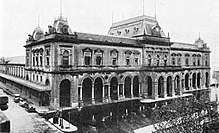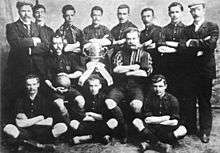Central Uruguay Railway
The Central Uruguay Railway (CUR) was one of the five original rail systems in Uruguay. The other four were the Midland Uruguay Railway Co., the North Western of Uruguay, the Uruguay Northern, and the Uruguay East Coast Railway. CUR, including its leased and worked lines, was considered the most important system.[1] It controlled about 1,560 kilometres (970 mi) of track. The system operated four sections: the Central Uruguay Railway Original Line (including the Northeastern Line), 436 km (271 mi); the Northern Extension Railway, 298 km (185 mi); the Eastern Extension Railway, 501 km (311 mi); and the Western Extension Railway, 340 km (211 mi).[2]

Overview

Central Uruguay Railway Co. of Montevideo, Ltd. was registered In London in 1876.[3] It was the largest railway company in Uruguay. It operated from 1 January 1878 to January 31, 1949, when railroads were nationalized. It worked, leased and absorbed some smaller rail systems. By the end of the era of British railways in Uruguay, CUR had a network of 1,665 km (1,035 mi) standard gauge, about half of the total within the country. It owned about 170 steam locomotives and several thousand cars.[4] In 1891, CUR's British and Uruguayan employees founded the Central Uruguay Railway Cricket Club.[5]
Routes
The Central Co. included the Central Uruguay and the Northeastern lines. It operated the lines of the Western Extension, the Northern Extension, and the Eastern Extension companies. The Central ran from Montevideo to Santa Isabel, across the Rio Negro, with a branch from Santa Lucia to San José de Mayo; the Northeastern connected Montevideo and Minas. The Western Extension ran from San Jose to Mercedes, with a branch to the port of Colonia. The Northern Extension continued the Central from Santa Izabel to Rivera on the Brazilian border. The Eastern Extension started from a point on the Northeastern 32 km (20 mi) from Montevideo and ran to Melo, with a branch to Treinta y Tres.[6]
References
- Koebel, William Henry (1911). Uruguay (Public domain ed.). C. Scribner's Sons. pp. 304–. Retrieved 25 December 2011.
- United States. Bureau of Manufactures; United States. Bureau of Foreign and Domestic Commerce (1918). Special agents series (Public domain ed.). G.P.O. pp. 353–. Retrieved 25 December 2011.
- Latin-American year book for investors and merchants for ... (Public domain ed.). Criterion Newspaper Syndicate. 1919. pp. 528–. Retrieved 25 December 2011.
- "Historia" (in Spanish). Administración de Ferrocarriles del Estado. Archived from the original on 14 April 2012. Retrieved 25 December 2011.
- Finn, Gerry P. T.; Giulianotti, Richard (2000). Football culture: local contests, global visions. Psychology Press. pp. 136–. ISBN 978-0-7146-5041-8. Retrieved 25 December 2011.
- United States. Bureau of Foreign and Domestic Commerce; United States. Bureau of Manufactures (1914). Special agents series (Public domain ed.). Govt. printing office. pp. 189–. Retrieved 25 December 2011.